If Google Ads is part of your marketing strategy, then you’re probably always looking for ways to boost your results.
Not only do you want to get more clicks, but you also want to get more quality clicks – users who take action after visiting your targeted pages.
But that’s easier said than done. You can spend countless hours tweaking each advert while A/B testing for subtle differences in copy and structure – or you can utilise Google Ads Extensions.
You’re probably familiar with Google Ads extensions; you’ve probably read about them and may even be using them already.
But you may not realise that Google adds more types almost every year.
This guide will help you understand each type of ad extension so you can optimise them for best results and get more out of your PPC dollars.
Google Ad Extensions Basics
Let’s start at the beginning.
What are Google Ads extensions?
You’ve probably already guessed the answer: Google Ads extensions extend your adverts to take up more space on search engine results pages (SERPs) and help searchers make decisions.
Why use them?
Ad extensions are so common that almost every advertiser can benefit from them, and they have two main benefits:
1. they allow you to provide more information: larger ad text allows you to make a stronger case to your target audience as to why they should click on your advert.
2. they increase your visibility on the SERPs: the larger the size of the extended advert, the greater the impact.
By these two factors alone, advertised additional messages can significantly increase your click-through rate (CTR), potentially by several percentage points. This doesn’t even take into account their other benefits, which include:
- Improved lead quality: by providing more information, extended ads can reduce irrelevant clicks by allowing lower quality leads to disqualify themselves. Users who click through to your targeted pages are more likely to take the desired action.
- Better Ad Ranking: Google uses a variety of factors to determine your ad ranking, including expected click-through rate, relevance, and landing page experience. Simply using additional information on your advert automatically improves your ranking as it allows Google to serve a wider variety of ad formats.
- Make better use of your PPC budget: Since ad extensions increase your click-through rate, they can help lower your cost-per-click (CPC), which in turn means you get more out of your paid ad spend.
Manual and Automatic Extensions
There are two general categories of extensions: manual (which require some setup) and automated.
Most of the extensions discussed here are manual, but some of them can also be applied dynamically by Google when Google predicts they will improve performance.
It’s worth noting that Google announced several changes to automated extensions in February 2022, including allowing them to be displayed alongside manually-added extensions such as sitelinks, annotations, and structured summaries (more on that later).
This allows your ads to occupy more SERP zones and generate more clicks.
They can also be added at the ad group, campaign or account level and can be included in reports.
14 Google Ad Extensions
Now that we’ve covered the basic categories of extensions, let’s dive deeper into the different types.
1. Address extensions
Address extensions list your location in one line to help people find your location, map or distance. These may also include phone numbers or call buttons for mobile users.
Author’s screenshot, March 2022 
This extension can be applied automatically and is perfect for any business that relies on face-to-face transactions, including restaurants, retail shops, and service providers such as barber shops or beauty salons.
It’s also beneficial for major online companies, as the physical address adds legitimacy in the eyes of your customers.
2. Product extensions
Product extensions allow you to enhance your product listings by linking your Google Merchant account to Google Ads.
This is a useful tool for any campaign where you sell items related to your target keywords.
Author’s screenshot, March 2022
Since products are more specific than locations or phone numbers, you’ll want your campaigns to be more detailed, especially if you sell a wide variety of products.
3. Website link extensions
Website link extensions can be used to direct users to other pages on your website, allowing targeted users to choose where they want to go rather than just visiting your login page.
Making it easier for users to find the content they are looking for can significantly increase your click-through rate.
Author’s screenshot, March 2022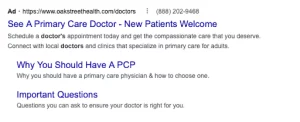
Common pages used in conjunction with site links include ‘contact us’ pages, pricing pages, sales pages and testimonials pages.
E-commerce sites use them to great effect when directing customers to specific category pages.
These can be added manually or dynamically as automatic extensions.
4. Seller Rating Extension
Showcase your business’s reputation and build trust with seller ratings extensions.
Google collects ratings from reputable business review sites and aggregates them into a single five-star rating.
This extension displays your overall rating as well as the total number of reviews. They also sometimes include qualifiers to describe the rating (e.g., same-day delivery).
Author’s screenshot, March 2022
These automatic extensions usually only appear if you have a minimum number of unique reviews and an average rating of 3.5 stars or higher.
5. Annotation
Annotation extensions are versatile, multi-purpose extensions that are 25-character snippets used to highlight important selling points, sales, or any other key points about your business, products, or services.
Author’s screenshot, March 2022
For example, if you want to advertise a 25% discount, free shipping or celebrate your company’s 60th anniversary, additional promotional messages are perfect.
You’re allowed six of these extensions per campaign, and they need to apply to the entire product you’re promoting.
The best additional promotional messages tend to use numbers and specifics (e.g., ‘5 pieces left in stock’ works better than ‘limited quantity left’).
If your website contains useful information such as ‘book online’, these descriptions can also be automatically added as dynamic markup.
6. Structured Summary Extension
Structured summaries are identified by a colon and can be used to highlight specific products, services and features that a user may be looking for.
They account for 35.1 per cent of all clicks and tell searchers who you are and what you offer, thus increasing the quality of clicks and helping you stretch your budget further.
As with site links, you can select them manually or Google can apply them dynamically.
7. Call extensions
Additional call information makes it easy for searchers to make calls directly from your adverts. They provide mobile users with a click-to-call phone number in your advert.
These conversions are tracked so you can measure the value of your ads by the number of calls they generate.
Author Screenshot, March 2022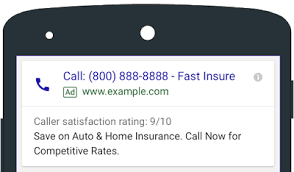
You can add call extras manually or have Google apply them automatically.
8. Affiliate business address extensions
Affiliate location extensions are very useful for companies that sell their products through third-party retailers.
They help users find nearby shops that carry your products and help them decide where and what to buy.
These are usually used by manufacturers who work with large retail chains, as they do not specify the location of your own business.
9. Price Extensions
It’s no secret that price is a key factor in almost all purchasing decisions.
Price extensions allow you to pre-set cost expectations, create transparency and help build trust with searchers.
As a result, when users visit your site, they are more informed and more likely to make a purchase.
Author’s screenshot, March 2022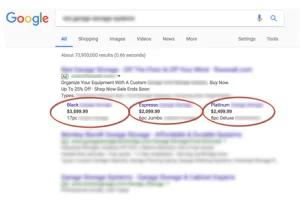
These extensions are useful for businesses with variable pricing, selling service packages, or offering many different products.
10. App extensions
From local pizza shops to real estate agents, it seems like everyone has a mobile app these days.
By providing a download link in a text ad, app extras make your app easily accessible to interested users while allowing you to track downloads based on keywords.
Author Screenshot, March 2022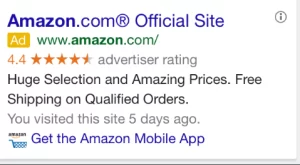
These will only appear to users on mobile devices and direct users to apps in the iTunes or Google Play Store.
11. Promotional extensions
Attract more clicks from users searching for the best deals by using promotional extras.
Used to highlight sales and promotions, they appear below your advert and are displayed using the price tag icon or in bold.
You can also display up to two lines of copy to provide users with more information.
Author Screenshot, March 2022
The beauty of these features (apart from their effectiveness) is that Google has the flexibility to decide how you use them.
You can display promotional extensions on specific days, dates or even hours, and you can also use pre-populated event tags such as Black Friday or end of summer.
12. Lead Forms Extension (New)
Instead of filling out forms on your destination pages, the latest Google Ads Extension and Lead Forms Extension allow users to submit their contact information directly on the SERPs.
Author Screenshot, March 2022
If the searcher uses their Google account, they can pre-populate with relevant information and submit with just one click.
This helps bring qualified leads into your marketing channel and shortens the sales cycle.
13. Video extensions
Video extensions allow you to display drive actions below video ads on the YouTube mobile app, giving you the opportunity to extend your message beyond the main video and keep viewers engaged.
Author’s screenshot, March 2022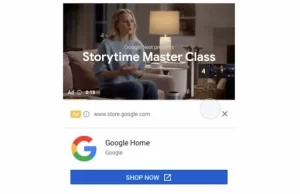
14. Image extensions
Image extensions help improve results by allowing you to supplement your text ads with relevant visuals.
Not every advertiser qualifies for such extensions and must meet certain requirements, including compliance history, a Google Ads account in an eligible vertical, and a running active campaign.
Author Screenshot, March 2022
How to Set Up and Create Google Ads Extensions
Now that you’ve learnt about the different types of Google Ads extensions and how they can work for you, let’s look at how to set them up.
The first thing you need to do is identify your goals and which extensions can help achieve them.
Do you want customers to contact you? Visit your website? Submit their contact information?
Figure out what you want the goal to do and then choose extensions that will help achieve that goal.
From there, it’s a simple process:
- Sign in to your Google Ads account.
- Select your campaign or ad group.
- Click on the ‘Ads & Extensions’ tab and then click on ‘Extensions’.
- Select the extensions you want.
- Customise each type of extension.
- Click ‘Save’.
Final Thoughts
If you’re looking for an easy way to increase click-through rates, attract more web visitors, and convert more targets, then ad extensions are a great tool.
With so many types to choose from, there is an extension for every organisation, no matter what industry they belong to.
It’s up to you to decide which one best suits your needs, but one thing is for sure: when applied correctly, they will help you get more quality leads and make the most of your PPC budget.
More Resources:
- Everything you need to know about ad extensions
- Google Ads Makes Changes to Auto Extensions
- The Complete PPC Marketing Guide for Beginners